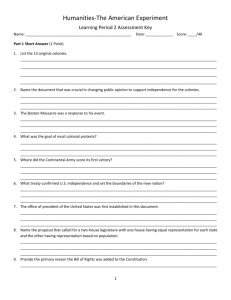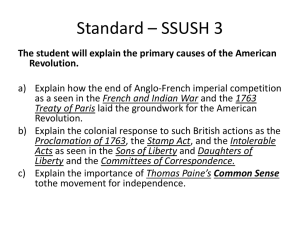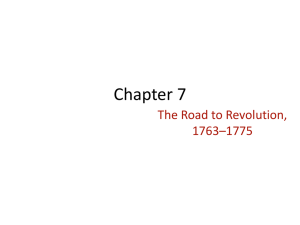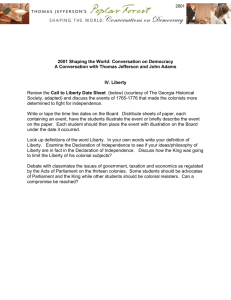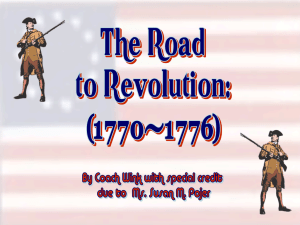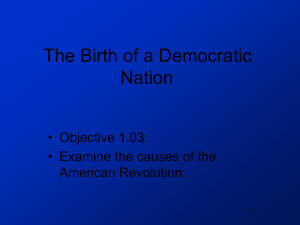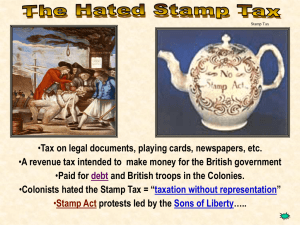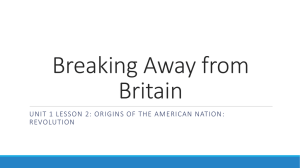CAUSES OF THE AMERICAN REVOLUTION: Interpreting Political
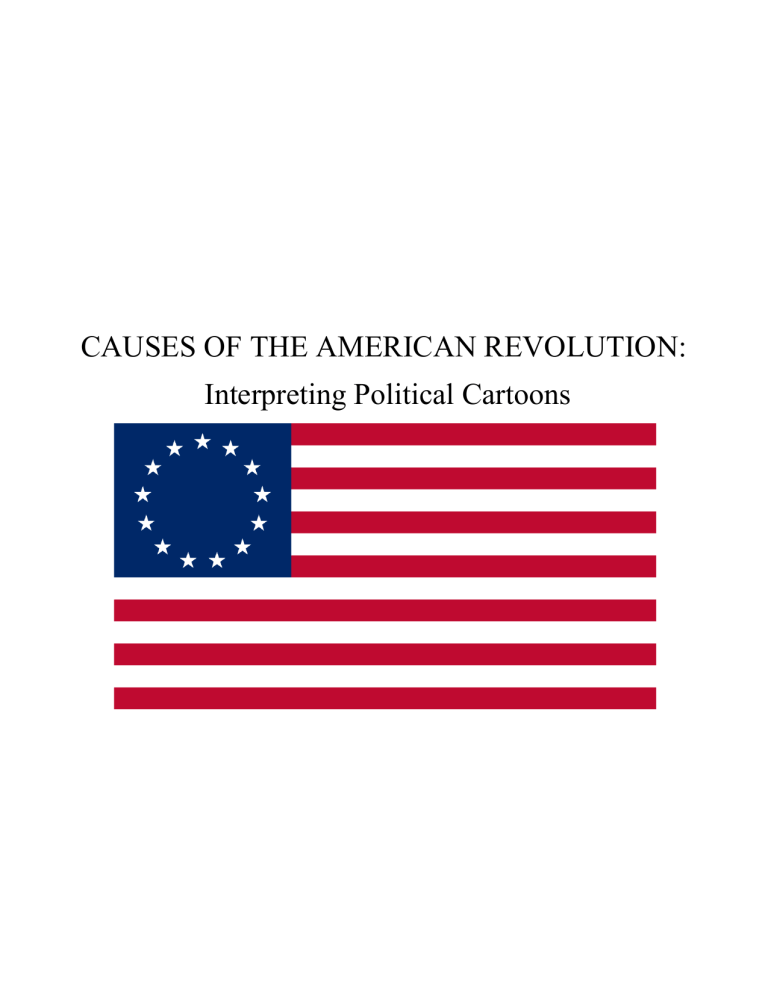
CAUSES OF THE AMERICAN REVOLUTION:
Interpreting Political Cartoons
ALBANY CONGRESS, 1754
HISTORICAL BACKGROUND:
Representatives of seven colonies met in Albany to secure the allegiance of the Iroquois Confederacy, and to unite the colonies in matters of defense. Benjamin Franklin proposed the Albany Plan of Union, which provided for a congress of delegates representing all the colonies. England rejected it because each was unwilling to give up any of its powers of local government to a grand council.
This was America’s first political cartoon, which appeared in Franklin’s newspaper shortly after the
Albany Congress. This drawing was based on the popular superstition that a snake that had been cut in two would come to life if the pieces were joined before sunset. This drawing immediately caught the public’s eye and was reproduced in other newspapers.
1.
What does each segment of the snake represent?
2.
What does the order of the segments illustrate?
3.
What does the entire snake represent?
4.
What does the caption mean?
5.
What statement best describes the message of the political cartoon? a.
To kill a snake, you must cut it up b.
The colonies must unite together to be strong or they will perish c.
If a snake grows back together, the colonies will be strong.
STAMP ACT, 1765
“No Taxation without Representation”
HISTORICAL BACKGROUND:
In 1765, upon George Grenville’s recommendation, the British Parliament enacted the Stamp Act as a means of raising colonial tax revenues to help pay the cost of the French and Indian War in North America.
The Stamp Act was the first direct tax imposed by Britain on its American colonies. This law placed a tax on newspapers, almanacs, pamphlets, playing cards, and legal documents.
The Colonists reacted immediately, asserting that the Stamp Act was an attempt to raise money in the colonies without the approval of colonial legislatures. Patrick Henry in the Virginia House of Burgesses stated
“No Taxation without Representation”. This became the slogan of the day. Patriotic societies, known as “The
Sons of Liberty” were formed to organize resistance to the tax; resistance to the act was demonstrated through debates in the colonial legislatures, written documents (including legislative resolves, prints, and songs), and mob/crowd actions such as tarring and feathering tax collectors. Merchants pledged to halt the import of British goods, and the people vowed to stop buying English products until the tax was repealed.
1.
What are the people protesting?
2.
Who do the dolls hanging from the trees represent?
3.
How did the colonists protest the tax?
4.
What does the sign “The Folly of England and the Ruin of America” mean?
5.
What is meant by “NO taxation with representation”?
STAMP ACT REPEALED, 1766
THE REPEAL. Or the Funeral Procession of MISS AMERIC-STAMP
ARTIST: ANONYMOUS. 1766
HISTORICAL BACKGROUND:
England was disturbed over the violent colonial opposition to the stamp tax. English merchants suffered severely from the colonial boycott of English goods. Therefore, Parliament in 1766 repealed the stamp tax but, at the same time, asserted its right to tax the colonies. Parliament had full authority over the colonies “in all cases whatsoever.”
1.
What does repeal mean?
2.
Who is the funeral for?
3.
What does the coffin represent?
4.
Why do they depict it as a child’s coffin?
5.
How can you tell this is in England?
6.
Why are the warehouses empty along the Thames River?
7.
Why are there ships in the harbor?
8.
Why are the British so full of grief and despair?
9.
Why did the British need the colonies?
10.
Who does the dog represent?
11.
Explain the actions of the dog?
BOSTON MASSACRE, 1770
Paul Revere’s print of “The Bloody
Massacre perpetrated in King Street” in
Boston, March 5, 1770. Three weeks after the occurrence, Revere was advertising his prints for sale in Boston’s newspapers. Revere’s historic engraving is long on political propaganda and short on accuracy. Patriotic propaganda like this called the incident a massacre to stir up feelings against the British government.
HISTORICAL BACKGROUND:
The people of Boston threatened and harmed British customs officials trying to collect taxes. So, the British quartered troops in Boston to protect their officials (Quartering Acts). In Boston, as elsewhere, there were bitter feelings between the colonists and the redcoats, the British troops. On one occasion, a riotous crowd of
Bostonians shouted insults and threw snowballs at a detachment of soldiers. The redcoats fired into the mob, killing five townspeople and wounding six others. The angry citizens, led by Samuel Adams, demanded the removal of the British troops. To prevent an uprising, the governor withdrew the soldiers from the city. News of the massacre spread throughout the colonies and aroused hatred everywhere.
1.
What does “propaganda” mean?
2.
How did Paul Revere stir up anti-British sentiment among his fellow colonists?
3.
Why isn’t this a true depiction of what happened?
4.
Why did Revere misrepresent what happened?
5.
Why is this considered a milestone in America’s road to independence?
BOSTON TEA PARTY 1773
Detail of The Bostonians Paying the Excise
(tax) Man (1774), a color engraving by an unknown artist. The sign on the Liberty
Tree is upside down and reads “Stamp Act”.
The put has the word “TEA” printed on it.
HISTORICAL BACKGROUND:
The British East Indian Company was in financial distress, partly as a result of the colonial boycott of English tea. To save the company from ruin, Parliament passed the Tea Act, which allowed the company to ship tea to America without paying the existing heavy duty in England. This allowed the company to sell the tea more cheaply than the colonial importers of
English tea as well as the smugglers of foreign tea. This would ruin many
American tea merchants.
In many American ports, the colonists boycotted the tea. It was either sent back to England, or locked up in warehouses and left to rot. In Boston, with the encouragement of The Sons of Liberty, the citizens refused to permit the unloading of three tea ships. During the night of
December 16, 1773, the Boston Tea Party took place. Bostonians disguised as Indians boarded the ships and dumped 342 chests
(worth $75,000) into the harbor.
1.
What does “boycott” mean?
2.
What event is taking place on the ships in the background?
3.
Why are they doing this?
4.
Who is being tarred and feathered?
5.
What are they pouring into his mouth?
6.
Who are the people committing the act?
7.
What does “Liberty Tree” mean?
8.
Who do they want liberty from?
9.
Why is the “Stamp Act” turned upside down on the tree?
INTOLERABLE ACTS, 1774
HISTORICAL BACKGROUND:
Parliament moved quickly to punish Massachusetts for the Boston Tea Party and to reassert its authority over the colonies. It passed a series of acts that the colonists called “intolerable.” This political cartoon shows colonial protest against the Intolerable Acts. In August of 1774, the Williamsburg Resolutions were passed.
Virginians were urged to sign a pledge of loyalty to the Continental Congress and to stop the export of tobacco to England, the colonies’ major and most profitable crop, until all taxes on imported goods were repealed.
The Alternative of Williams-Burg
1.
Why did the colonists call the new acts “intolerable”?
2.
Why would some colonist want to refuse to sign the pledge not to sell tobacco to England?
3.
What would happen to them if they didn’t sign? (what is hanging from the gallows?)
THE SHOT HEARD AROUND THE WORLD
HISTORICAL BACKGROUND:
Anticipating war, the citizens of Massachusetts began to organize themselves into an army, or militia.
They called themselves the Minutemen , since they stood ready for action at a minute’s notice. General Gage, the British military governor of Massachusetts, sent troops to capture the revel ringleaders John Hancock and
Samuel Adams, who were rumored to be in Lexington, and seize the stores of ammunition and weapons hidden in Concord.
The colonials, however, learned of Gage’s plans. Two Patriots, Paul Revere and William Dawes, rode through the night and warned the countryside of the oncoming British. When the British troops arrived at
Lexington, the local Minutemen met them. In an exchange of shots, 18 colonials were killed or wounded. This
British proceed to Concord, and another skirmish took place. As the English marched back to their base in
Boston, the aroused colonials, hiding behind houses, trees, and stone walls, poured a steady fire into the redcoats. Almost 4,000 Americans participated in the action of the day. The British suffered 273 casualties, the colonials 93.
In March 1775, just before the outbreak of hostilities in Massachusetts, Patrick Henry delivered his famous speech, “Give me Liberty or Give Me Death!”
1.
Who were the Minutemen and how did they get their name?
2.
Where were the first shots fired that began the American Revolution?
3.
Why did the British send troops to Lexington and Concord, Massachusetts?
4.
Why did the British lose so many more men than the Americans?
5.
What did Patrick Henry mean when he said “Give me Liberty or give me death?”
CAUSES OF THE AMERICAN REVOLUTION Name: ________________________________
INTERPRETING POLITICAL CARTOONS Document Based Questions
Document 1: ALBANY CONGRESS, 1754
1.
What does each segment of the snake represent?
2.
What does the order of the segments illustrate?
3.
What does the entire snake represent?
4.
What does the caption mean?
5.
What statement best describes the message of the political cartoon? a.
To kill a snake, you must cut it up b.
The colonies must unite together to be strong or they will perish c.
If a snake grows back together, the colonies will be strong.
Document 2: STAMP ACT, 1765 “No Taxation without Representation”
1.
What are the people protesting?
2.
Who do the dolls hanging from the trees represent?
3.
How did the colonists protest the tax?
4.
What does the sign “The Folly of England and the Ruin of America” mean?
5.
What is meant by “NO taxation with representation”?
Document 3: STAMP ACT REPEALED, 1766
1.
What does repeal mean?
2.
Who is the funeral for?
3.
What does the coffin represent?
4.
Why do they depict it as a child’s coffin?
5.
How can you tell this is in England?
6.
Why are the warehouses empty along the Thames River?
7.
Why are there ships in the harbor?
8.
Why are the British so full of grief and despair?
9.
Why did the British need the colonies?
10.
Who does the dog represent?
11.
Explain the actions of the dog?
Document 4: BOSTON MASSACRE, 1770
1.
What does “propaganda” mean?
2.
How did Paul Revere stir up anti-British sentiment among his fellow colonists?
3.
Why isn’t this a true depiction of what happened?
4.
Why did Revere misrepresent what happened?
5.
Why is this considered a milestone in America’s road to independence?
Document 5: BOSTON TEA PARTY, 1773
1.
What does “boycott” mean?
2.
What event is taking place on the ships in the background?
3.
Why are they doing this?
4.
Who is being tarred and feathered?
5.
What are they pouring into his mouth?
6.
Who are the people committing the act?
7.
What does “Liberty Tree” mean?
8.
Who do they want liberty from?
9.
Why is the “Stamp Act” turned upside down on the tree?
Document 6: INTOLERABLE ACTS, 1774
1.
Why did the colonists call the new acts “intolerable”?
2.
Why would some colonist want to refuse to sign the pledge not to sell tobacco to England?
3.
What would happen to them if they didn’t sign? (what is hanging from the gallows?)
Document 7: THE SHOT HEARD ‘ROUND THE WORLD, April 19, 1775
1.
Who were the Minutemen and how did they get their name?
2.
Where were the first shots fired that began the American Revolution?
3.
Why did the British send troops to Lexington and Concord, Massachusetts?
4.
Why did the British lose so many more men than the Americans?
5.
What did Patrick Henry mean when he said “Give me Liberty or give me death?”
CRITICAL THINKING
Answer the following questions by giving examples from the information and political cartoons above.
1.
How did people get the news during the Revolutionary Period?
2.
Was the information always accurate or biased? Cite an example
3.
How were political cartoons used to stir up anti-British sentiment among the colonists?
4.
What did the colonists do to show their displeasure with England’s actions?
5.
What were some of the causes that made the colonist go to war with England?
6.
What have you learned about how the colonists thought about England’s actions by viewing their political cartoons?
7.
What do Americans do today to show they do not agree with their government’s actions?
